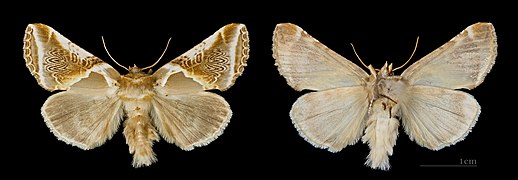Buff arches
Appearance
| Buff arches | |
|---|---|

| |
| Scientific classification | |
| Kingdom: | |
| Phylum: | |
| Class: | |
| Order: | |
| Family: | |
| Genus: | |
| Species: | H. pyritoides
|
| Binomial name | |
| Habrosyne pyritoides (Hufnagel, 1766)
| |
| Synonyms | |
| |
The buff arches (Habrosyne pyritoides) is a moth of the family Drepanidae. It is found throughout Europe and is well distributed in the British Isles except the far north of England and all of Scotland.
This is a distinctive and attractive species, its grey-brown forewings marked with bold buff-orange “arches." The hindwings are grey with white margins. The wingspan is 40–45 mm. It flies from June to August [1] and is attracted to light and sugar.
The larva is orange-brown with a prominent white spot on each side of the head and feeds on bramble, hawthorn and hazel. The species overwinters as a pupa.
- ^ The flight season refers to the British Isles. This may vary in other parts of the range.
-
Both sides
Subspecies
- Habrosyne pyritoides pyritoides (Europe, Northern Iran)
- Habrosyne pyritoides derasoides (Butler, 1878) (south-eastern Russia, Korean Peninsula, Japan, China: Heilongjiang, Jilin, Liaoning, Beijing, Hebei)
References
- Chinery, Michael Collins Guide to the Insects of Britain and Western Europe 1986 (Reprinted 1991)
- Skinner, Bernard Colour Identification Guide to Moths of the British Isles 1984
External links
Wikimedia Commons has media related to Habrosyne pyritoides.
Wikispecies has information related to Habrosyne pyritoides.


